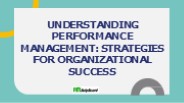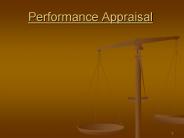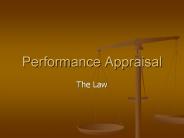Employee Performance Appraisal PowerPoint PPT Presentations
All Time
Recommended
Performance appraisal is a systematic evaluation of an employee's job performance. It provides valuable feedback on strengths and areas for improvement, guiding decisions on promotions, compensation, training, and development. This process is essential for aligning individual performance with organizational goals, ensuring that employees' contributions effectively support the company's objectives. Through regular appraisals, organizations can enhance employee growth, satisfaction, and overall productivity.
| PowerPoint PPT presentation | free to download
Performance appraisal is a systematic evaluation of an employee's job performance. It provides valuable feedback on strengths and areas for improvement, guiding decisions on promotions, compensation, training, and development. This process is essential for aligning individual performance with organizational goals, ensuring that employees' contributions effectively support the company's objectives. Through regular appraisals, organizations can enhance employee growth, satisfaction, and overall productivity.
| PowerPoint PPT presentation | free to download
Performance appraisal is a systematic evaluation of an employee's performance to assess their productivity, skills, and contributions to organizational goals. It provides constructive feedback, identifies areas for improvement, and recognizes achievements. This process helps align individual goals with company objectives, fostering professional growth and motivation. Effective appraisals encourage open communication between employees and managers, driving better workplace relationships and enhanced performance. Learn how performance appraisal benefits both employees and organizations in achieving long-term success.
| PowerPoint PPT presentation | free to download
Enhance employee performance with a structured performance appraisal plan that drives growth, aligns individual goals with organizational objectives, and fosters continuous improvement. Empower teams through clear feedback, actionable insights, and effective strategies to achieve measurable success and professional development.
| PowerPoint PPT presentation | free to download
Performance appraisal in HRM is a critical process that helps organizations assess employee performance, identify areas for improvement, and align individual goals with company objectives. It involves setting clear expectations, providing feedback, and promoting employee development. Effective performance appraisals contribute to motivation, productivity, and overall organizational success, fostering a positive work culture.
| PowerPoint PPT presentation | free to download
An appraisal letter is a formal document issued by an employer to an employee, summarizing the results of a performance review. It includes feedback on the employee’s work performance, achievements, strengths, and areas for improvement. The letter often outlines specific goals, provides ratings or evaluations, and may include recommendations for career development or salary adjustments. It serves to formally communicate performance outcomes and set expectations for future performance. The tone is constructive, supportive, and professional, aiming to motivate and guide the employee.
| PowerPoint PPT presentation | free to download
Bell curve appraisal is a performance management method that ranks employees on a distribution scale, identifying top performers, average contributors, and underperformers. It ensures a balanced workforce by promoting fairness and aligning individual goals with organizational objectives. This approach is widely used to enhance productivity and foster talent development within organizations.
| PowerPoint PPT presentation | free to download
Bell curve appraisal is a performance evaluation method that categorizes employees into different performance levels. This system helps in identifying top performers, average contributors, and underperformers. It enables effective decision-making in talent management, compensation, and promotions, ensuring a fair and data-driven approach to employee assessments and fostering a culture of continuous improvement.
| PowerPoint PPT presentation | free to download
Performance appraisal -- setting standards, informing employees, ... THE PERFORMANCE MANAGEMENT CYCLE. 3 PARTS OF PERFORMANCE SYSTEM. DEFINING PERFORMANCE ...
| PowerPoint PPT presentation | free to view
www.performanceimprovementsystem.com Shifting the manager's mindset from top down performance appraisal to collaborative performance improvement system is key to making it work.
| PowerPoint PPT presentation | free to view
... and reward behaviors aligned with organizational mission and goals To reach organizational mission and goals What do Employees Expect? Clear expectations ...
| PowerPoint PPT presentation | free to download
Be prepared for some common challenges of the appraisal process ... Tone. Body Language. Stay focused on performance. Dates to Remember ...
| PowerPoint PPT presentation | free to view
Unit 2, Lecture 4: Performance Appraisal PERFORMANCE APPRAISAL CONCEPTS Prof. John Kammeyer-Mueller MGT 4301 Unit 2, Lecture 4: Performance Appraisal Unit 2, Lecture ...
| PowerPoint PPT presentation | free to view
Performance appraisal is a systematic evaluation of an employee's job performance. It provides valuable feedback on strengths and areas for improvement, guiding decisions on promotions, compensation, training, and development. This process is essential for aligning individual performance with organizational goals, ensuring that employees' contributions effectively support the company's objectives. Through regular appraisals, organizations can enhance employee growth, satisfaction, and overall productivity.
| PowerPoint PPT presentation | free to download
Preparing for Your Performance Appraisal DiscussionA Briefing for EmployeesOffice of Human Capital ManagementProfessional Development CenterLynda Jones and Sara ...
| PowerPoint PPT presentation | free to view
Performance appraisal is a systematic evaluation of an employee's job performance. It provides valuable feedback on strengths and areas for improvement, guiding decisions on promotions, compensation, training, and development. This process is essential for aligning individual performance with organizational goals, ensuring that employees' contributions effectively support the company's objectives. Through regular appraisals, organizations can enhance employee growth, satisfaction, and overall productivity.
| PowerPoint PPT presentation | free to download
An appraisal letter is a formal document issued by employers to recognize an employee’s performance, achievements, and contributions over a specific period. It typically includes details about salary revisions, promotions, or additional benefits. This letter serves as a record of appreciation and motivates employees to maintain or enhance their performance in the future.
| PowerPoint PPT presentation | free to download
Preparing for Your Performance Appraisal DiscussionA Briefing for EmployeesOffice of Human Capital ManagementProfessional Development CenterLynda Jones and Sara ...
| PowerPoint PPT presentation | free to view
A performance appraisal policy outlines the process by which employee performance is evaluated. It aims to assess individual achievements, set goals, provide feedback, and identify areas for improvement. The policy typically includes clear criteria for evaluation, such as job knowledge, quality of work, and teamwork, and may incorporate both self-assessments and manager reviews. Regular appraisals promote employee development, align individual goals with organizational objectives, and guide compensation and promotion decisions. The policy ensures fairness, transparency, and consistent feedback, fostering a culture of continuous improvement.
| PowerPoint PPT presentation | free to download
Performance management involves continuous processes to enhance employee performance through goal setting, feedback, and development. It aligns individual objectives with organizational goals, boosting productivity and fostering growth. This system ensures the effective use of human resources by regularly evaluating and guiding employees, ultimately contributing to organizational success. Through ongoing support and development, performance management helps create a motivated and skilled workforce dedicated to achieving the company's objectives.
| PowerPoint PPT presentation | free to download
Performance management tools are essential for monitoring, evaluating, and enhancing employee performance, ultimately contributing to organizational success. These tools include 360-Degree Feedback, which gathers performance insights from peers, subordinates, and supervisors for a comprehensive evaluation, and Key Performance Indicators (KPIs), which are quantifiable metrics used to measure performance against specific goals. Performance Appraisal Software automates evaluations, tracks progress, and maintains detailed performance records. Employee Self-Assessment encourages individuals to reflect on their performance and identify areas for improvement. Goal-Setting Tools assist in establishing, tracking, and achieving performance objectives, while Continuous Feedback Systems facilitate real-time, ongoing feedback between employees and managers. Collectively, these tools support continuous improvement, align individual and organizational goals, and enhance overall productivity.
| PowerPoint PPT presentation | free to download
Performance appraisal is a systematic process to evaluate employee performance, aligning individual goals with organizational objectives. It helps identify strengths, areas for improvement, and career development opportunities, ensuring growth and productivity within the workplace.
| PowerPoint PPT presentation | free to download
Performance appraisal is a systematic evaluation of an employee's job performance. It provides valuable feedback on strengths and areas for improvement, guiding decisions on promotions, compensation, training, and development. This process is essential for aligning individual performance with organizational goals, ensuring that employees' contributions effectively support the company's objectives. Through regular appraisals, organizations can enhance employee growth, satisfaction, and overall productivity.
| PowerPoint PPT presentation | free to download
A performance appraisal used in the organization is a regular review of employee’s job performance to verify their contribution to the company. It is also known as annual review or performance evaluation. It evaluates the skills, growth, achievement or failure of the employees.
| PowerPoint PPT presentation | free to download
Performance appraisal is a systematic evaluation of an employee's job performance. It provides valuable feedback on strengths and areas for improvement, guiding decisions on promotions, compensation, training, and development. This process is essential for aligning individual performance with organizational goals, ensuring that employees' contributions effectively support the company's objectives. Through regular appraisals, organizations can enhance employee growth, satisfaction, and overall productivity.
| PowerPoint PPT presentation | free to download
Performance appraisal is a systematic evaluation of an employee's job performance. It provides valuable feedback on strengths and areas for improvement, guiding decisions on promotions, compensation, training, and development. This process is essential for aligning individual performance with organizational goals, ensuring that employees' contributions effectively support the company's objectives. Through regular appraisals, organizations can enhance employee growth, satisfaction, and overall productivity.
| PowerPoint PPT presentation | free to download
Appraisal process,methods with illustrations.
| PowerPoint PPT presentation | free to download
Enhance your organization’s growth with a comprehensive Performance Appraisal Policy. Promote employee development, ensure fair evaluations, and align individual goals with business objectives. This policy serves as a guide to fostering accountability, recognizing achievements, and encouraging continuous improvement in your team. Empower your workforce with a structured and transparent appraisal process tailored to drive success
| PowerPoint PPT presentation | free to download
Performance appraisal is the process by which organizations evaluate employee job performance. ... The ratings used to evaluate employee performance. Subjective ...
| PowerPoint PPT presentation | free to download
Title: Performance Appraisal Author: Oak Training Ltd. Last modified by: Meredith Bunche Document presentation format: On-screen Show (4:3) Company
| PowerPoint PPT presentation | free to view
Bell curve appraisal, also known as forced distribution, is a performance evaluation method that ranks employees into predefined categories based on their performance. Typically, it distributes employees into three groups: top performers, average performers, and low performers, following a bell-shaped curve. This method aims to identify high achievers for rewards and development while addressing underperformance. However, it can be controversial, as it may create competition and affect morale. Proper implementation and communication are essential for its effectiveness.
| PowerPoint PPT presentation | free to download
Appraisal interview style Purposes of evaluation Manager s philosophy of management Institutional guidelines Key behaviors for an appraisal interview Put the ...
| PowerPoint PPT presentation | free to view
A 360-degree appraisal is a performance review method where an employee receives feedback from multiple sources: supervisors, peers, subordinates, and sometimes, clients. This holistic approach provides a comprehensive view of the employee's strengths and areas for improvement. It encourages open communication, fosters a culture of continuous development, and mitigates biases by balancing perspectives. Typically conducted via surveys or questionnaires, the feedback is then aggregated and analyzed to guide personal and professional growth, ultimately enhancing overall organizational performance.
| PowerPoint PPT presentation | free to download
Performance Appraisal Procedures Instruct employees to complete self-evaluation (interactive PDF form via HR website) Employees have maximum of ONE WEEK to complete ...
| PowerPoint PPT presentation | free to view
Performance Appraisal * * Definition Performance Appraisal is the systematic evaluation of the individual with respect to his or her potential for development.
| PowerPoint PPT presentation | free to download
Title: PERFORMANCE APPRAISAL Author: alder Last modified by: College of Business Created Date: 8/31/2000 1:35:03 AM Document presentation format: On-screen Show
| PowerPoint PPT presentation | free to view
Assign appropriate proportions of people to each performance category ... Customers/clients/suppliers. Performance Appraisal: Interview. Purpose ...
| PowerPoint PPT presentation | free to view
HRM Intervention 3 Due 5/6/05 before 3:00 PM via Email ... Appraise Performance. Provide Feedback. Developmental vs. Pay. How Do Organizations Assess? ...
| PowerPoint PPT presentation | free to download
Performance Appraisal The Law Considering the legal aspects An exhaustive analysis of the legal implications of performance appraisal would be difficult, if not ...
| PowerPoint PPT presentation | free to download
Bell Curve Appraisal is a method of Forced Ranking System, this Bell Curve HR appraisal categorize Employee’s Performance for Rewards & Penalties.
| PowerPoint PPT presentation | free to download
PERFORMANCE APPRAISAL TEAM B1 Gurbani Dassan Sophie Bellone Fawaz Iqbal Farhaan Mirza Nikhil Nair TABLE OF CONTENTS What is Performance Appraisal Examples of AP ...
| PowerPoint PPT presentation | free to download
linking people and jobs to the Bank's objectives, giving everyone a part of the ... Tackling poor performers. Employee can express disagreement. Supportive MIS ...
| PowerPoint PPT presentation | free to view
Critical to ensure no surprises. MANAGING THE APPRAISAL PROCESS. Preparation. Goal Setting ... Information Gathering. Discussion. Opening. Getting Input ...
| PowerPoint PPT presentation | free to view
A management system designed to achieve organizational effectiveness by steering ... Companies avoid more frequent appraisals because they are considered too ...
| PowerPoint PPT presentation | free to view
Guide progress. Improve performance Business & Legal Reports, Inc. ... Discuss career advancement Business & Legal Reports, Inc. 0506. Appraisal Benefits ...
| PowerPoint PPT presentation | free to view
In 360 degree appraisal system an employee performance is evaluated by its colleagues, peers and the Manager and will rate the employee performance, Learn about what is 360 Degree Performance appraisal and its Method, process, feedback questions, review, evaluation, assessment
| PowerPoint PPT presentation | free to download
Provide timely feedback, especially to marginal or poor performers. ... In the case of poor performers, or persons dismissed or demoted, or those who ...
| PowerPoint PPT presentation | free to download
Appraising Employee Performance ... Informally, performance reviews should be conducted on a day-to-day basis with ongoing feedback from the supervisor.
| PowerPoint PPT presentation | free to download
Ensures alignment of individual performance and behavior to organization culture ... what increase should top performers receive ...
| PowerPoint PPT presentation | free to view
The Bell Curve Appraisal Method is a performance evaluation technique that uses a normal distribution to assess employee performance. This approach categorizes employees into three groups: top performers, average performers, and low performers. By ranking individuals on a bell curve, it helps identify strengths and areas for improvement while ensuring a fair and objective assessment process. This method is often used in performance reviews, promotions, and salary adjustments, offering a structured way to evaluate talent and foster a productive work environment.
| PowerPoint PPT presentation | free to download
Job Performance The degree to which one meets expectations of supervisors or ... Only sees limited facet or appraise. Gives input from immediate client group ...
| PowerPoint PPT presentation | free to view
Discuss the importance of criteria for performance appraisal ... some of the anxiety and defensiveness employees might experience when being ...
| PowerPoint PPT presentation | free to view
... for setting goals and coaching employees. Responding to employee ... process is an excellent coaching opportunity ... Through Coaching-Example #1 ...
| PowerPoint PPT presentation | free to view
Employee Performance Management Dr. Deming s View A measurement of: Training Communication Tools And skill of supervisors Not necessarily an employees motivation ...
| PowerPoint PPT presentation | free to download
Performance Appraisal System Team B3 Introduction of Performance Appraisal(PA) Strength and limitation of PA Suggestions for the performance Conclusion Outline ...
| PowerPoint PPT presentation | free to download
performance appraisal overview what is a pa ... systematic review three categories administrative performance improvement research implementation performance ...
| PowerPoint PPT presentation | free to view
























































